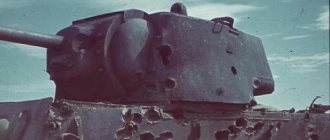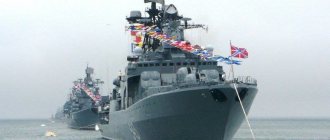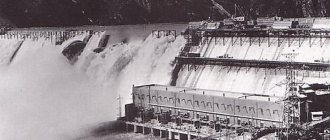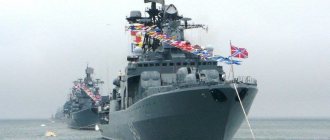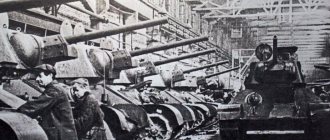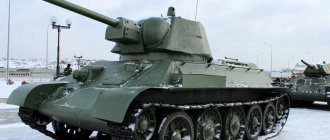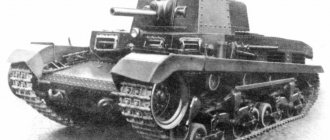The first generation of post-war tanks consisted of armored vehicles designed either during the war or immediately after using accumulated experience. In the USSR, the basis of the tank fleet was the T-54 and T-55, in the USA - the Patton, in Britain - the Centurion. They differed slightly from wartime tanks - mainly in more powerful weapons and enhanced protection.
However, new technologies appeared, new concepts for the use of armored forces were born - and later first-generation vehicles already combined proven solutions with fundamentally new ones. One of these tanks was the T-62.
History of creation
The T-54 and T-55 tanks were armed with a 100mm D-10T cannon. During the war, it was an extremely effective weapon, but already in 1950 it turned out that its BR-412 family shells did not have sufficient penetration to combat the armor of the latest tanks.
At this time, in Kharkov, under the leadership of Alexander Morozov, a completely new tank, the “object 430”, was being developed, which would later become the T-64. And the Uralvagonzavod design bureau, headed by Leonid Kartsev, began proactive work to create a medium tank with enhanced weapons.
During this search, we moved from the idea of a completely new design to the idea of ensuring maximum continuity with the T-55.
The promising 100mm rifled gun D-54TS with improved ballistics was considered as a weapon. After Khrushchev's order to create tanks with smoothbore guns, the D-54 was redesigned accordingly.
The armored vehicle with a smoothbore gun, designated "object 166", was successfully tested in 1960, and a year later it was put into service as the T-62.
Design bureaus
During the period under review, four design bureaus were involved in the development of tanks in the USSR. The design bureaus of the Leningrad Kirov Plant (LKZ) and the Chelyabinsk Tractor Plant (ChTZ) designed heavy tanks. The medium ones were traditionally handled by OKB-520 of Plant No. 183 (starting with the first “thirty-fours”), from which by the beginning of the 50s two tank design bureaus were actually formed - Design Bureau of Plant No. 183 or Uralvagonzavod (UVZ) in Nizhny Tagil and KB-60 in plant No. 75 in Kharkov.
The history of this division is as follows: in 1941, OKB-520 was evacuated from Kharkov along with plant No. 183 to Nizhny Tagil to the territory of UVZ, and it was here that this team under the leadership of A.A. Morozov created the T-44 and T-54 medium tanks. However, by the end of the 40s. Most of the experienced tank designers evacuated to Nizhny Tagil returned back to Kharkov to the newly established plant No. 75 here. And since 1951, the position of chief designer of the tank KB-60 of this plant was occupied by A.A. Morozov himself, who returned from Siberia (according to one version, his departure from plant No. 183 occurred due to disagreements with the management, precisely on fundamental issues of the design of the new tank). The design bureau team that remained in Nizhny Tagil, consisting mainly of young people, was headed by designer L.N. Kartsev.
Considering that the Uralvagonzavod bureau has not yet gained sufficient experience after the departure of the Kharkov designers, as well as the high authority of A.A. Morozov, as the creator of a number of successful designs, work on creating a new promising medium tank was initially entrusted to KB-60 of Kharkov plant No. 75.
Description of design
Externally, the T-62 remained so similar to the T-55 that it can only be identified by small details. But its design has changed quite seriously. To accommodate the new gun, the T-62 turret strap had to be increased, and for this purpose the tank hull had to be lengthened. To evenly distribute the load on the chassis, the rollers were positioned differently. Because of this, the gap between the front rollers, characteristic of the T-55, was replaced by an equally characteristic gap between the rear rollers.
Since the mass of the tank changed slightly - only by a ton - the T-62's power plant remained the same.
The 12-cylinder diesel B-55 developed a power of 580 hp. The B-55V engine differed only in the installation of a more powerful electric generator.
Fuel came from four tanks located inside the fighting compartment (three tanks in the bow and one in the stern, on the starboard side) and three external ones, installed on the fender. The tank's diesel engine was started with a pneumatic starter; an electric starter was available as a backup.
Torque was transmitted to the tracks through a “guitar” gearbox, a main clutch, a five-speed gearbox with synchronizers (except 1st gear) and planetary turning mechanisms. To set up a smoke screen, diesel fuel was injected into the exhaust manifolds of the T-62 diesel engine. The T-62 had an automatic fire extinguishing system and, in addition, a manual carbon dioxide fire extinguisher.
"Object 140"
In 1952, the Nizhny Tagil Design Bureau also joined the work on a promising medium tank. Its new boss, L.N. Kartsev, despite existing personnel problems, managed to obtain a government assignment for the development of a promising tank. UVZ director I.V. played a very large, if not the main, role in this. Okunev is a man of irrepressible character, strong-willed, and enjoys great authority in the Ministry of Transport Engineering. He showed constant interest in new technology and was a patriot of his plant. And receiving such a serious government task promised great advantages for both the design bureau and the plant: increased funding, an influx of qualified personnel, gaining experience, and most importantly, the deployment of mass production of a new tank in the future.
The Nizhny Tagil project received the designation “object 140”. The future vehicle was supposed to have an armored hull of a new, improved shape, be armed with a D-54T cannon (the same as the “object 430”), and the engine was supposed to be a new D-36 diesel engine (the maximum power of which, according to some sources, was supposed to be 700 hp .).
The experimental “object 140” had a hull with large angles of inclination of the armor plates (including the sides and roof). The thickness of the hull forehead armor is 100 mm. The turret, strongly reminiscent of the T-54 turret in shape, had armor in the front section of up to 240 mm. The armament was similar to the “object 430”. The gun was aimed using a TSh-2 telescopic sight. The engine is a multi-fuel diesel V-36, with a power of 700 hp, which was a modification of the engine of the V-2 family. Transmission - mechanical planetary. The chassis has small-diameter support rollers with external shock absorption and support rollers. In 1957, a prototype of the Nizhny Tagil “object 140” was built.
Tests of the “Object 140” revealed a number of serious shortcomings in the design of the engine and transmission; in addition, despite a large number of progressive design solutions, the vehicle as a whole turned out to be very low-tech. Ultimately, the chief designer of the UVZ design bureau, L.N. Kartsev, sent a letter to the CPSU Central Committee and the Council of Ministers with a request to exempt his design bureau from continuing work on the project of a promising medium tank.
Both prototypes, after passing factory tests, took part in comparative tests at the Research Institute of BT Test Site in Kubinka.
Crew accommodation and booking
Since the layout of the tank did not change significantly, the tankers also remained sitting in their original places. The driver's seat is in the front, to the left of the fuel tanks. To view the terrain, the T-62 driver used two periscopes, one of which allowed him to see the terrain along the course of movement, and the other - a sector slightly to the right. At night, one of the periscopes was replaced with a night vision device, working in tandem with an infrared headlight.
In the T-62 turret, to the left of the gun is the gunner, behind him is the commander, and to the right of the gun is the loader.
The commander's periscope TPKUB, installed on the T-55, was replaced by a combined device TKN-2, which had both day and night modes. An infrared spotlight was used to operate the device in night vision mode.
The gunner had at his disposal an optical sight of variable magnification (from 3.5 to 7 times) and a night sight, which required illuminating the target with an IR spotlight. In addition, the gunner could see the area directly in front of the tank through a prismatic periscope.
The armor protection of the T-62, compared to the T-55, has remained virtually unchanged. The thickness of the frontal armor plate (100mm) and its angle of inclination (60⁰) remained the same. The vertical sides made of 80mm thick armor have also been preserved. But due to the need to ensure the declination angle of the gun when firing backwards, the rear part of the roof of the T-62 hull received a characteristic slope, and the rear armor plate (45 mm thick) became almost vertical.
The thickness of the turret's armor also remained unchanged - from 200 mm on the forehead to 65 mm in the rear, but its projectile resistance increased.
The T-54 and T-55 turrets had a combined design - a roof made of rolled armor was welded to cast parts, and the welds created weakened areas. On the T-62, the turret became solid and the weakened areas in the armor disappeared.
"Object 430"
Work on a promising tank began in 1951, and by 1953 a preliminary design had already been developed in Kharkov, which was superior to the serial T-54 in all main parameters. The vehicle received the designation “object 430”. By the way, the first digit in the designation of post-war Soviet armored vehicles almost always identifies the design bureau that developed the vehicle. For example, the number 4 means that the vehicle was developed by KB-60 at Kharkov plant No. 75, the number 1 is equipment designed at OKB-520 of plant No. 183 (or UVZ) in Nizhny Tagil. According to the “Object 430” project, it was armed with a 100-mm D-54TS tank gun, for the purpose of which, for the first time, a TPDMS optical sight-rangefinder was installed on a medium tank. Its armor protection was strengthened by slightly increasing the thickness of the armor parts and installing them at large angles of inclination.
A prototype of the "object 430" medium tank with a 100 mm D-54TS tank gun
The prototype "Object 430" had a welded body made of rolled armor plates. Its bow was a multi-layer armor barrier with a rational angle of inclination of the front and zygomatic sheets. The spherical turret with a narrow embrasure for mounting a gun had differentiated three-layer armor protection. The D-54TS gun, coaxial with a 7.62-mm PKT machine gun, was stabilized in two planes by the Metel tank weapon stabilizer and had a mechanism for ejecting spent cartridges. The tank was equipped with an optical sight-rangefinder TPD-43 (TPDMS) with independent stabilization of the field of view in the vertical plane. To combat low-flying enemy targets, it was planned to install an anti-aircraft machine gun mount on the tank, equipped with a 14.5 mm KPVT machine gun. The tank was equipped with a more powerful five-cylinder 5TD engine (580 hp). Transmission - mechanical planetary. “Object 430” had a new chassis with small-diameter road wheels with internal shock absorption (instead of large rollers used since the BT and T-34 tanks) and a caterpillar track with a metal hinge. The tank's suspension system is individual, torsion bar with telescopic hydraulic shock absorbers on the first and sixth suspension units. The tank was equipped with a collective protection system against weapons of mass destruction and an automatic fire protection system. In 1957, three prototypes of the Kharkov “object 430” were ready.
Tests of the “430 object” were generally successful, although they revealed a number of shortcomings. In the conclusion of the testing commission, it was written that the requirements of the assignment of the Scientific and Technical Committee of the GBTU were generally fulfilled, and the experimental tank was superior in its characteristics to serial medium tanks. But the designers failed to achieve a significant increase in its firepower compared to the T-54, and given the fact that its design was completely new, its mass production would have caused inevitable problems in organizing maintenance, retraining personnel and repairs. Therefore, the adoption of the “430 object” was considered inappropriate. Its designer himself, A.A., shared the same point of view. Morozov.
Armament
The “main caliber” of the T-62 tank was the U-5TS “Molot” smoothbore 115mm gun. For the first time in Soviet practice, the gun was equipped with an ejector; in addition, to reduce gas contamination, a cartridge ejection mechanism was used. This decision was later assessed as controversial. On the one hand, gas pollution actually decreased, and the tank crew did not have to waste time collecting spent cartridges lying around in the fighting compartment.
On the other hand, the mechanism did not operate instantly, and the loader of the T-62 was forced to wait for its operation to finish before loading a new projectile. This reduced the practical rate of fire. The gun was equipped with a two-plane electro-hydraulic stabilizer "Meteor".
The main armor-piercing ammunition of the T-62 was feathered sub-caliber projectiles with a detachable tray - 3BM4 with a steel core and 3BM3 with a tungsten core. A “steel” projectile at a distance of a kilometer could penetrate armor up to 250mm thick, a “tungsten” one - up to 300mm. Compared to 100mm BR412 shells, which could penetrate such armor only at point-blank range, this was a huge leap forward.
It is worth noting that the USSR was ahead of NATO countries in the development of this type of ammunition.
As an alternative to “blanks”, a 3BK4 cumulative projectile was proposed, filled with 1.5 kg of A-IX-1 explosive and having a steel cumulative funnel. The armor penetration was 440mm. The 3OF11 high-explosive fragmentation projectile contained 2.6 kg of TNT, versus 1.4 kg for the 100mm OF412 projectile.
The T-62 ammunition consisted of 40 shells, most of which were placed in storage near the MTO partition and in the front tank racks. The first-stage ammunition rack consisted of only two shells, located at the side of the turret next to the loader’s position.
Additional armament included a 7.62mm SGMT coaxial machine gun and a DShK large-caliber anti-aircraft machine gun above the loader's hatch.
Game Tips
This tank has two options for action in battle. The first is a rush (zerg) and the second is a mid-range damage dealer.
Let's look at rush tactics. For this we need a platoon leader, because it is easier to cooperate with him than to look for a comrade in the chat. It is also worth noting that the comrade should not be on a T-95, but at least on a medium tank. Of course, the ideal option is the second T-62A.
So, a striking example of the “rush” tactic is the Himmelsdorf map, only in the Encounter battle mode. Perhaps the mountain is one of the most important points on the map in a counter battle, and the outcome of the battle depends mainly on whether you took the mountain or not. I also want to say that taking a mountain is the task of fast, maneuverable tanks and the respawn point also has a strong influence.
If you were born on Maus at the bottom of the mountain, this does not mean that you need to suffer and go up, go to the banana. The IS-7 can afford to drive up the mountain. We haven't been distracted for long, let's continue. Another important parameter is the number of opponents opposing you and allies coming to your aid.
There should be no more than three opponents (if you focus on the skill) and no more than two (if you are not Flash), because if you fly into full opponents and there are four of them, you will simply merge, under the onslaught of enemy fire. The highlight of this tactic is to arrive faster than everyone else and dismantle the “fast” enemy forces while the “main” ones are still rising to meet you.
Now let's talk about having teammates behind you, because after destroying the enemies on the mountain, you don't need to press further. You run the risk of running into a tank destroyer, which will penetrate you without hesitation and cause a thousand damage. And who knows, maybe there are also heavy tanks there, so there is no need to rush forward, it is better to wait for the allies who are full, unlike you, and let them go forward. IN
An important aspect of this tactic is working on “focus”, that is, when flying at two opponents, you should not shoot at different targets, but choose one (preferably with a lower health level) and deal damage only to it, without being distracted by anyone.
Well, after successfully suppressing the mountain and all the tanks still climbing it, you can freely and easily drive along the zero line, kill the artillery and, as usual, break the capture and destroy all opponents.
Now let’s look at the second option for fighting: “damage dealer”
A striking example is the Sand River map, and again only in the Assault battle mode. On this map, one of the key points is a mountain, from which you can easily highlight and damage enemies trying to get to the first line. For this tactic, we don’t need a comrade; we can deal damage ourselves.
We need cover in the role of a tank destroyer behind our back, which can also work on our “light.” To do this, at the beginning of the battle it is better to warn in the chat, so that this does not become an unpleasant surprise, both for your artillery and for the tank destroyer. It is literally not worth standing in this position, because you are blocked by the mountain from all enemy equipment, except for artillery, which can happily throw a couple of splashes at you.
If you see that the enemy is in large forces on squares B2, C2, and you are without cover (artillery and tank destroyers), then you can safely leave this position, because you will not be allowed to leave and fire a shot without taking damage. This tank is very comfortable to shoot at medium and long distances, because like all medium tanks, it fires sub-caliber shells (they are considered the main ones and are bought for silver), whose projectile speed is higher than that of armor-piercing and, therefore, high-explosive ones. There is no need to take a large lead when shooting at a moving target.
Also, the highest rate of fire among medium tanks of level 10 and excellent aiming make shooting extremely simple. And when shooting on the move, the aim is so small that it is very difficult to miss (better than Patton-3). After destroying all the tanks on our flank, it makes sense to stay on the mountain and move to the other flank and push the opponents from the mountain into the sides, or move down the mountain and go to the opponents’ flank and push them into the stern. In this situation, we need to analyze if the opponents have already pushed through the second flank and on the approaches to our base, we need to move along the mountain, and if not, then we can move down the mountain.
Modifications
Initially, it was planned to put into production a tank with a D-54TS cannon, called T-62A, but production was limited to a small pre-production batch. The command tank with additional radio and navigation equipment received the designation T-62K. T-62, during production, which received new radio stations and PKT machine guns instead of SGMT, were not allocated to separate modifications.
After the outbreak of hostilities in Afghanistan, large-scale programs began to modernize the T-55 and T-62 tanks still in service.
As a result, the T-62M variant was created. The engines of the modified tanks were boosted to 680 hp, the side armor was supplemented with rubber-fabric screens, and combined armor blocks were installed on the front plate and on the turret. The bottom was reinforced for better protection against mines.
T-62M received laser rangefinders and ballistic computers. The armament was strengthened with new ammunition. The 3BM21 projectile with a tungsten core penetrated up to 390mm of armor at a kilometer range, and the 3BM28 from depleted uranium - up to 420mm. The 3BK15M cumulative projectile with a copper cumulative funnel had a penetration of 500 mm of armor. In the 3OF27 high-explosive fragmentation projectile, the weight of the explosive was increased to 3.13 kg, and TNT was replaced with hexal.
In addition to new shells, the T-62M gained the ability to launch 9M117 guided missiles from the gun barrel. Auxiliary weapons were supplemented with smoke grenade launchers, and the DShK machine gun was sometimes replaced by the NSVT. Dynamic protection was installed on the T-62MV, and the Drozd active protection complex was tested on the T-62D.
Booking model.
The tank has good ricochet armor. The thickness of the frontal armor plate is 102mm. The indicator is certainly weak in relation to other medium tanks of level 10, but it is tilted at 60 degrees, and the lower armor plate is at 55 degrees, which of course complicates the penetration of the tank.
The front armor of the turret is 240mm and again this is not a Mouse turret. It is round and the armor is located at wild angles, so it is almost impossible to penetrate the T-62A turret.
Main performance characteristics
The American M60 tank and the later series of the British Centurion should be considered direct analogues of the T-62. The M60, which has a pedigree from tanks from the Second World War, was supposed to become a “transitional” between the previous vehicles and the new MBT. The Centurion, created back in the 40s, was constantly improved until it gave way to the new Chieftain.
| T-62 | M60 | Centurion Mk.10 | |
| Weight, t | 37 | 46 | 52 |
| Length, m | 6,6/9,3 | 6,9/9,3 | 7,2/9,8 |
| Width, m | 3,3 | 3,6 | 3,3 |
| Height, m | 2,4 | 3,2 | 2,9 |
| Frontal armor, mm | 100 | 93 | 120 |
| Side armor, mm | 80 | 74 | 50 |
| Armament | 115mm cannon, 12.7mm machine gun, 7.62mm machine gun | 105mm cannon, 12.7mm machine gun, 7.62mm machine gun | 105mm cannon, 7.62mm machine gun |
| Maximum speed, km/h | 50 | 48 | 38 |
In terms of overall dimensions and weight, the T-62 was inferior to all analogues. This made it less noticeable and vulnerable, but on the other hand, the small vertical guidance angles limited the tank’s ability to fire from cover. The American tank was inferior to the Soviet T-62 in mobility, but no one had decisive advantages in firepower and armor.
Since its introduction, the British Centurion has received more decent armor and powerful weapons. Its weakest point remained disgusting mobility - a consequence of the use of a capricious and unreliable carburetor engine. It should be noted that the American 105mm gun was a licensed copy of the British version - that is, they were the same.
Operators
Modern
- Algeria - 300 T-62, as of 2010
- Angola - 50 T-62, as of 2010
- Afghanistan - a number of T-62s, as of 2010. 255 T-62 units were supplied from the USSR: 100 T-62 units were delivered between 1975 and 1976, 155 T-62 units were delivered between 1979 and 1991. Between 12 and 50 T-62K units were delivered from Russia in 2001.
- Vietnam - 70 T-62, as of 2010
- Egypt - 500 T-62 in storage, as of 2010
- Israel - 126 T-54/55 and T-62S, as of 2010
- Iran - more than 75 T-62, as of 2010
- Yemen - 200 T-62, as of 2010
- Kazakhstan - 280 T-62, as of 2007
- North Korea - more than 3,500 medium and main tanks, including the T-62, as of 2010. 500 T-62 units were supplied from the USSR: 350 T-62 units were delivered between 1971 and 1975, 150 T-62 units were delivered between 1976 and 1978. 470 T-62 units were produced under license under the designation Chonma-Ho between 1980 and 1989
- Cuba - more than 900 Medium and Main Tanks, including the T-62, as of 2010. 400 T-62 units were supplied from the USSR between 1976 and 1988.
- Libya - 100 T-62 plus 70 in storage, as of 2010
- Russia - 150 T-62 plus 350 in storage, as of 2010
- Syria - 1000 T-62K and T-62M, as of 2010
- Somalia
- Tajikistan - 7 T-62, as of 2010
- Uzbekistan - 170 T-62, as of 2010
- Ethiopia - more than 246 T-54/55 and T-62, as of 2010. 70 T-62 units were supplied from the USSR: 20 Czechoslovak-made T-62 units were delivered in 1977, 50 T-62 units were delivered in 1980.
Former
- Bulgaria - 250 T-62 units were supplied from the USSR between 1970 and 1974. Removed from service.
- Belarus - 170 T-62, as of 1995, withdrawn from service
- Iraq - 2850 T-62 units delivered from the USSR: 100 T-62 units delivered from 1974 to 1975, 600 Czechoslovak-made T-62 units delivered from 1977 to 1979, 2150 T-62 units delivered from 1982 to 1989. Removed from service
- Moldova
- Mongolia - 100 T-62 units were supplied from the USSR between 1973 and 1975. Removed from service
- Northern Yemen - 16 T-62 units delivered from the USSR in 1980
- USSR - 2022 T-62, as of 1991, went to the states formed after the collapse
- Sudan
- Tanzania
- Ukraine
- PDR Yemen - 270 T-62 units were supplied from the USSR: 50 T-62 units were delivered in 1972, 100 T-62 units were delivered from 1981 to 1982, 120 T-62 units were delivered in 1986.
Combat use
The first real battle for the T-62 was the border conflict on Damansky Island. In it they suffered their first losses - the tank of the border detachment commander, Colonel Leonov, was hit by a hand grenade launcher. The damaged T-62 stood on the ice of the river until it broke through. Later, the Chinese picked up the tank and took it to the museum.
In Afghanistan, Soviet T-62 tanks operated mainly as mobile bunkers and escorted convoys.
They were often used for night attacks, taking advantage of the availability of night vision equipment. Despite the fact that the Mujahideen actively used anti-tank grenade launchers, most of the losses suffered by Soviet tanks were from mines.
After the collapse of the USSR, a significant number of T-62s remained in the armored forces, which were subject to reduction. They were indeed removed from the Russian army, but not for processing, but under the Ministry of Internal Affairs - into the internal troops. In this capacity, old tanks took part in both Chechen campaigns.
In the early 70s, the T-62 was received by Arab countries - Egypt and Syria. Accordingly, their participation in the next Arab-Israeli war became inevitable. By the beginning of the 1973 war, Egyptian tank crews did not have time to properly master the vehicles and suffered heavy losses in battles. The situation was no better in Syria, where during one of the battles the Israelis managed to repel an attack by five T-62s using an outdated Bazooka and rifle grenades. However, the Israelis gave the captured tanks quite high marks.
During the Iran-Iraq War, the T-62 was successfully used by the Iraqi army. In 1991, the “sixty-second” no longer participated so successfully in battles with anti-Iraqi forces. In Africa, the Sixty-Second used Cuban troops (in Angola) and the Libyans in an attempted invasion of Chad.
The T-62 became the crowning achievement of the family of medium tanks, the first of which was the T-44.
It brought to perfection the ideas laid down before, and implemented new ones for the first time. And the modernizations of the 80s showed that although the “sixty-second” cannot become a full-fledged MBT, it is quite capable of operating effectively in modern conditions.
Now the tank, of course, is largely outdated - even reinforced armor is not enough to protect against modern ATGM missiles. But where, first of all, a simple, unpretentious and powerful combat vehicle is needed, the T-62 can still show itself.
Stories about weapons. T-62 tank outside and inside
It has a lot in common with the previous hero of our reviews, the T-54/55 tank.
Just as simple, convenient, reliable as its predecessor. Yes, the war in Afghanistan revealed the tank’s shortcomings, but more on that below. Our intelligence played a major role in the appearance of the T-62. It was thanks to the clear actions of our intelligence officers that the country's leadership received very unpleasant information in a timely manner.
The discussion was about the adoption of new 105 mm tank guns by NATO countries. This gave a significant advantage to the potential enemy tanks over our T-54 and T-55.
By that time, it was no secret that our 100-mm gun of the T-55 tank could no longer penetrate the frontal armor of the American M48 Patton III tank, but the Americans already had the M60 Patton IV on the way. With the new gun, the M60 generally began to have such an advantage that it caused serious concern among everyone in the Union.
But we have to agree that we not only knew how to catch up and overtake, but we knew how to do it masterfully. Moreover, since the time of Joseph Vissarionovich.
In Nizhny Tagil, where the Uralvagonzavod design bureau is located, work on the next generation tank began from the moment the T-54 was put into service. This is the so-called “Object 140”, which was built in metal, but did not go into production. However, the developments of the Object 140 went into use and were used to create the Object 165, the prototype of the new tank.
“Object 165” inherited from its predecessor the hull, turret, engine compartment, transmission and mechanism for automatically ejecting cartridges through the rear hatch of the turret.
“Object 165” was planned to be equipped with a new 100-mm rifled tank gun U-8TS, which was a modernization of the D-54TS gun. In principle, all the innovations of the modernization consisted of the “Comet” stabilizer instead of the “Molniya” on the D-54TS.
The Comet was a more modern stabilizer, but the problem was not with stabilizing the barrel. There were a whole bunch of complaints about the gun, the main one being the insufficient penetrating ability of the projectile.
It is quite logical that simultaneously with the “Object 165”, the development of the “Object 166” began, for which they began to develop another weapon.
If it’s correct, then, of course, don’t develop it. The gun had already been developed by that time in the design bureau of the Yurga Machine-Building Plant No. 75. It was developed as a particularly powerful T12 anti-tank gun with a 100 mm caliber.
A special feature of this gun was the absence of rifling in the barrel. The gun was developed as a smoothbore gun, and here's why: cumulative projectiles have greater penetrating power if they are not given any torque.
For the T12 gun, special feathered armor-piercing projectiles were developed, which also did not need to be imparted with torque. At a distance of 1 km, this gun penetrated armor 215 mm thick, which in theory was quite enough to fight the main tanks of NATO countries.
Naturally, the idea of installing the T12 on a tank immediately arose, since it turned out that a smoothbore gun was almost half as powerful as a rifled one.
However, in practice everything turned out to be not so simple. The shells developed for the T12 could not be used in the tank due to their size. The length of the unitary cartridge was 1,200 mm, which is completely normal for an artillery gun, but in a tank with such a cartridge it is simply impossible to turn around.
Therefore, the smoothbore gun for the tank had to be made from the U-8TS. The 100 mm gun had its barrel rifling removed, increasing its caliber to 115 mm. Due to the absence of rifling, it became possible to significantly increase the pressure of the powder gases and thereby increase the initial velocity of the projectile.
The new gun did not have a muzzle brake, which was welcomed by the military. The gun barrel was lengthened. This is how the world’s first smoothbore tank gun, the U-5TS “Molot,” was born.
Contrary to many fears, the accuracy of fire of the new gun turned out to be at the level of the best tank rifled artillery systems of that time.
The basic model of the T-54 also underwent changes and modifications. The front-mounted machine gun on the new tank was removed, and the mounting method for the coaxial PKT machine gun was changed due to the replacement of the gun.
The new tank gun turned out to be too heavy for the Comet and Molniya gun stabilizers in service. A new Meteor stabilizer was developed for the new weapon.
The layout of the tank was classic: the control compartment was located in front, the fighting compartment behind it, and the engine and transmission compartment in the rear of the tank.
On the left side of the control compartment there was a place for the driver, who reached him through a hatch located directly above the seat in the turret armor plate. Behind the seat in the bottom there was a spare escape hatch.
At night, the TNV-2 night vision device was added to the optical devices, which allowed the driver to see the road at a distance of 60 m in front of the tank. The infrared headlight was located next to the regular headlight on the right side of the body. Underwater, the tank was controlled using a direction indicator.
In the fighting compartment there was a tank commander (rear left in the turret), a gunner (front right in the turret) and a loader (rear right in the turret).
In the roof of the turret there were two hatches that opened forward: the left one was for the commander, the right one was for the loader.
On tanks produced since 1972, a DShKM large-caliber anti-aircraft machine gun was located behind the loader's hatch. The ammunition for the machine gun consisted of 300 cartridges in belts.
The gun's ammunition consisted of 40 shells and was located in the fighting compartment. Since unitary cartridges weighed quite decently, from 22 to 30 kg, the most physically strong guys were selected for the role of loaders. But at the same time, the large weight of the projectile became the reason for the development of an automatic loader.
And the Acorn AZ was developed and even tested at Object 166. But the T-62 went into production without the AZ, which took quite a long time to be perfected. And “Acorn” served as a prototype for the creation of an automatic loader for the T-72 tank.
The power plant was a 12-cylinder four-stroke diesel engine V-55V with a power of 580 hp. The highway range was 450–650 km.
The tank was equipped with an anti-radiation protection system that could operate in both automatic and semi-automatic modes. With the help of a supercharger-separator, excess pressure was created inside the tank, which did not allow toxic substances to penetrate inside the vehicle in the event of its depressurization.
The T-62 was equipped with an automatic fire extinguishing system. Fire-fighting equipment extinguished fires in the corresponding compartment with a mixture consisting of ethyl bromide, carbon dioxide and compressed air. It could also operate in both automatic and semi-automatic modes.
In the summer of 1961, both “Object 165” and “Object 166” were recommended by the commission for adoption. “Object 165” received the index T-62A, “Object 166” became T-62.
The T-62A was produced in a pilot series of 25 tanks, and then its production was stopped so as not to “produce” an excessive number of models.
The T-62 was produced in the USSR until 1975, in Czechoslovakia from 1973 to 1978, and in the DPRK from 1980 to 1989. In total, about 20,000 vehicles of various modifications were produced.
The T-62 was first shown at the Parade on November 7, 1967. The first combat use took place during the events of 1968 in Czechoslovakia, but since there were no active hostilities there, we are not talking about full use.
The T-62 received its real baptism of fire in 1969 during the Soviet-Chinese conflict on Damansky Island. A platoon of three T-62s tried to help the border guards defending on the island by crossing the branch of the Ussuri River that separated them on the ice.
The Chinese knocked out the tank of Colonel Leonov, who died along with the crew, and were even able to capture the tank. Chinese experts carefully studied the T-62 and used Soviet technical solutions found in it when designing their model Tour 69 (WZ-121).
T-62s were actively used in Afghanistan. Naturally, the vehicle, which performed well in battle, began to be transferred and sold to other countries.
The tank fought a lot in the Middle East as part of the Syrian and Egyptian armies during the Six Day War and the Yom Kippur War.
Subsequently, the T-62, under the name “Tiran 6,” fought in the Israeli army, since more than 200 vehicles were simply abandoned and lost by the Arab military due to command errors and unprofessional crews.
Syria later used its T-62s in the 1982 Lebanon War. The Iraqi Army used the T-62 extensively during the Iran-Iraq War of 1980–88, during the attack on Kuwait, and in defense during the Gulf War in 1991. T-62s were used by Libyan troops during Muammar Gaddafi's invasion of Chad in November 1986, as well as during the joint French-American Operation Odyssey Dawn against him in 2011.
Today T-62s are actively participating in the war against terrorists in Syria.
Overall, the T-62 has proven itself to be a worthy successor to the T-55. Just as simple, reliable, easy to maintain and repairable.
Combat operations showed that the maximum gun pointing angle of +16° is insufficient, especially in mountainous conditions. Application in the deserts of the Middle East brought operational problems associated with dust. The 40 rounds of ammunition is quite good, but due to the large size of the shells, only part of the ammunition is placed in the turret. For the same reason, used cartridges are not returned to the ammunition racks, but are thrown out through a special hatch.
But overall, it was an excellent fighting vehicle of that era, which showed itself worthy on the battlefields.
Sources: Baryatinsky M. Medium tank T-62. Statsenko A. T-62: the smoothbore is returning.
